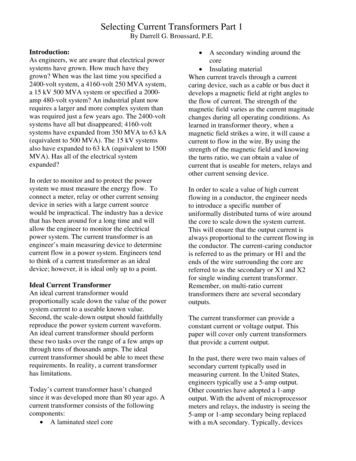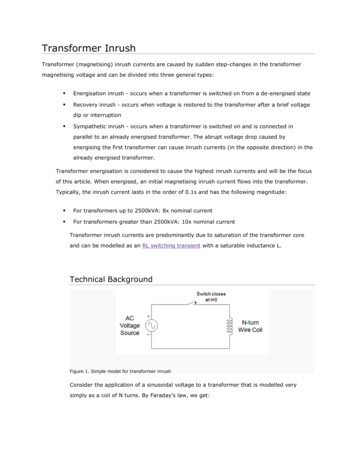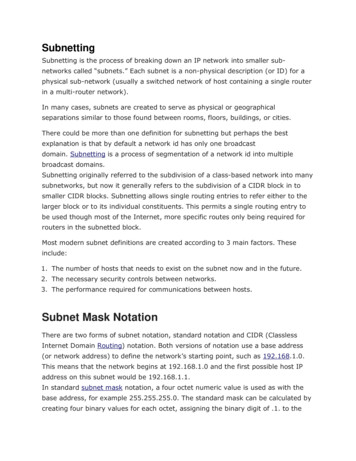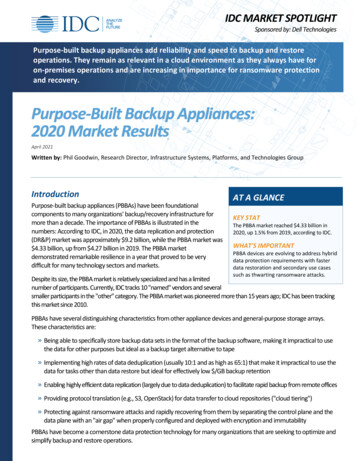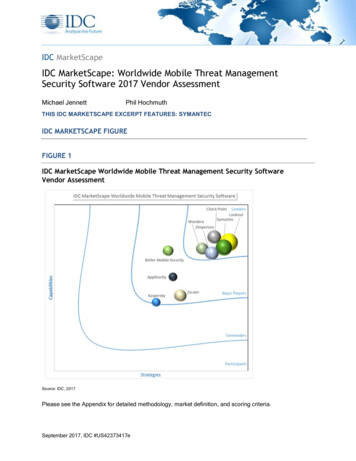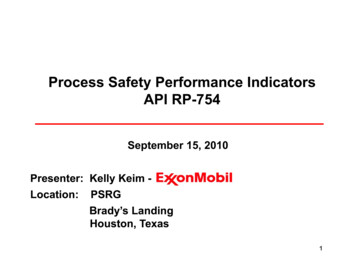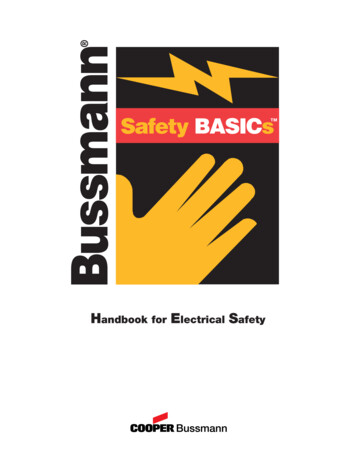
Transcription
Bussmann Safety BASICsHandbook for Electrical Safety
Safety BASICs (Bussmann Awareness of Safety Issues Campaign)This is an unproven compilation of technical materials that has been assembled by the developers for the benefit oftraining others about “Electrical Safety”, including electrical “Arc-Flash” hazards. It is being presented to illustrate thecritical nature of electrical safety practices. While not the only method(s) or answer(s), or perhaps not even the bestmethod(s) or answer(s), in the opinion of the developers/presenters the content is an accurate, acceptable, and positiveway to present the subject material. The National Fire Protection Association’s NFPA 70E - 2000 introduces safe workpractices to mitigate the flash hazards identified by this work. By creating awareness of the potential hazards anddescribing workable solutions by which the hazards can be controlled, minimized or eliminated, it is hoped that injury willbe reduced and lives will be saved.Use of the information contained in the Safety BASICs program material is at your own risk.Those seeking permission to reproduce portions of this document must contact Cooper Bussmann, Inc. for appropriate license.
A special thanks goes to Ray A. Jones PE with Electrical Safety Consulting Services, Inc.,(ESCS, Inc.) who provided consultation services for the Safety BASICs program material.Ray is a professional engineer with more than 35 years of experience in developing andoperating electrical safety systems and processes in industrial units. Ray retired from theDuPont Company in 1998 where he held the position of Principal Consultant, concentrating on electrical safety systems and processes as well as codes and standards. Ray isactive in multiple technical committees for NFPA, including NFPA 70E, which covers electrical safety requirements for employee workplaces. He is a senior member of theInstitute of Electrical and Electronic Engineers (IEEE).Ray has authored or co-authored ten technical papers covering safety systems andprocesses, five of which have been published in IEEE Transactions on IndustryApplications, and five of which earned awards from IEEE. He is a frequent lecturer andcontributor at the IEEE-IAS Petroleum and Chemical Industry Committee Electrical SafetyWorkshop and other IEEE tutorials.To learn more about services offered by ESCS, Inc., contact Ray Jones at 919-557-7711,rayjones@ieee.org or jandrjones@worldnet.att.net.Safety BASICs - Bussmann Awareness of Safety Issues CampaignCopyright 2001 Cooper BussmannAll Rights ReservedPrinted in the U.S.A
Bussmann Safety BASICs3
Table of ContentsI.Introduction .1II.Consensus Standards .2A.B.C.D.E.III.Types of StandardsNFPA 70 (National Electrical Code - NEC )OSHA StandardsNFPA 70EOther Standards and ResourcesElectrical Hazards.7Attending to Electrical Accident Victims .15A.B.C.IV.A.B.C.Electrical ShockArc FlashArc BlastProceduresAdditional InformationAdvance Help for Accident VictimsV.Who’s Responsible for Safety?.19VI.Electrical Accident and Hazard Prevention.20A.B.C.D.E.F.G.H.I.J.Approach BoundariesInsulation Flashover DistancesFlash Hazard AnalysisPersonal Protection EquipmentHazard/Risk AnalysisLockout/TagoutStored Energy SystemsIP2X (Finger-Safe) RatingsGrounding and Ground Fault Circuit Interrupters (GFCI)Voltage Testing—1,000 Volts and BelowVII.Establishing an Electrical Safety Program.44VIII.Planning Work Procedures .A.B.IX.45.46ProceduresDocumentationPrinciples for Safety.A.B.C.Training, Planning and Written ProceduresProviding an Electrically Safe Work ConditionDesigning an Electrical System for SafetyX.Costs Associated with Safety .55XI.Standards Designed for Safety.57XII.References/Glossary of Terms .57XIII.Appendix:.60.62A.B. Safety BASICs - Safety Awareness Quiz .BussmannXIV.Checklist for Victims of Electrical AccidentsSources of Informationi4 Safety BASICs
I.IntroductionAn increasing number of organizations are actively promoting electrical safety foremployees. For example, the National Fire Protection Association NFPA 70E“Standard for Electrical Safety Requirements for Employee Workplaces” has beencompletely updated. The Institute of Electrical and Electronics Engineers (IEEE) justpublished a new “Yellow Book,” the “IEEE Guide for Operation, Maintenance andSafety of Industrial & Commercial Power Systems.” The University of ChicagoTrauma Center has a new unit specializing in electrical burns and related injuries.Its interests are not only on improving treatment methods, but also providing moreinsight of electrical injuries and awareness on how to avoid electrical hazards. Majormanufacturers and entire industries are seeing benefits of becoming more involvedin promoting employee safety awareness programs.The purpose of this Safety BASICs handbook is to: provide increased awareness of safety issues faced by individuals who workon or near electrical equipment, as well as system operators and equipmentdesigners/specifiers and to provide safety principles to be used for protecting individuals frompotential injuries and even death caused by electrical hazards.This material is designed to provide the reader with an overview of hazards associated with exposure to electrical energy. It will highlight standards and standard organizations, and offer guidance on safety procedures and a number of key principles thatwill help to minimize exposure to electrical hazards. Knowing how to minimize theexposure to electrical hazards will help to reduce future injuries and even deaths.The Safety BASICs program is for the supervisor, manager, electrician, engineer,and the designer/specifier of equipment used in the electrical system. The IEEEmakes it very clear that, “Engineers engaged in the design and operation of electricalsystems protection should familiarize themselves with the most recent OSHA regulations and all other applicable regulations related to human safety.” To the IEEE,providing adequate safety means going beyond the minimum requirements fromconsensus standards.Bussmann Perhaps a statement in the IEEE “Buff Book” says it best - “Safety has priority overservice continuity, equipment damage or economics.” Safety BASICs1
Consensus StandardsConsensus standards are seen as the generally accepted engineering practices andcan be used for litigation purposes when entered as evidence in a legal proceeding.In case of an accident, where litigation is involved, the design and safety practicesused will be compared with these standards. In some cases this type of enforcement is more critical than if the government were the enforcing agent.In the United States, consensus standards are normally written by volunteers andpublished by standards developing organizations (SDOs). The content of consensusstandards is the result of a blue-ribbon panel of experts and defines the industry’sbest generally available knowledge. Consensus standards fall into several differentclasses. Some consensus standards are product oriented; others define testingrequirements, cover installation or design issues, or are people oriented. Manybecome legally mandated by governmental organizations.Whether a national consensus standard is mandated and enforced by governmentalaction or not, the judicial system tends to use these standards as generally recognizedand accepted engineering practices for litigation purposes. In order to understand thesignificance of this point, consider the text used in the OSHA Act: “the (Labor)Secretary shall.by rule promulgate as an occupational safety or health standard anynational consensus standard.” The legal profession will use relevant national consensus standards in a court case where the standard is entered into evidence.Each SDO and standard has a principle objective. In order to correctly apply anyindividual consensus standard, both the SDO objective and the standard objectiveshould be clearly understood. The standard then should be applied with this understanding in mind. For instance, the National Fire Protection Association (NFPA) is primarily concerned with fire protection and personal safety. Therefore, NFPA standards should be embraced when these objectives are considered important. SomeNFPA standards are product oriented; others are installation oriented. These standards should be applied as discussed in the scope of the document. The NFPA publishes two critical standards. One is the NFPA 70, otherwise known asthe National Electrical Code (NEC ) and the other is Electrical Safety Requirementsfor Employee Workplaces (NFPA 70E). The NFPA has many other standards, butthese are two of the most important electrical standards. The premier standards publishing organization in the U.S. is the American National Standards Institute (ANSI).ANSI is authorized by the U.S. government as the organization that has the authorityto identify American National Standards (ANS). No standard is written by ANSI;instead, ANSI identifies requirements for both the SDO and the standard. Amongthese is a requirement that each standard be produced by people knowledgeable inthe area being addressed. Each ANSI standard then is ensured to have had broad,knowledgeable input as well as a “consensus” by the community covered by thestandard.BussmannII.2 Safety BASICs
Most consensus standards define minimum requirements necessary to accomplishthe prime objective under normal operating or functioning conditions. Of course, inmost cases, a standard tends to define some protective measures. However, definedprotective measures are intended to protect the equipment from destruction in caseof a failure. Generally, consideration for the “people factor” is missing from the standards puzzle, even though actions of people account for more than 75 percent of allaccident incidents that result in injury.A. Types of StandardsThere exists, today, more than 22,000 national consensus standards in the UnitedStates. Standards Developing Organizations (SDOs) addressing electrical safetyinclude the American National Standards Institute (ANSI), National Fire ProtectionAssociation (NFPA), Institute of Electrical and Electronic Engineers (IEEE),Underwriters Laboratories (UL), the U.S. Occupational Safety and HealthAdministration (OSHA), and the National Electrical Manufacturers Association(NEMA). Note that these SDOs are mostly U.S. based and have primarily a U.S.focus.Each of these SDOs writes and publishes standards that address various electricalsafety issues. As stated earlier, some standards are intended for adoption by governmental organizations. However, national SDO developed consensus standardsnot adopted by governmental organizations can still be used in a court of law.B. NFPA 70 (National Electrical Code - NEC)NFPA 70 is commonly called the National Electrical Code or the NEC . The NECis currently adopted by more than 1,800 different governmental organizations in theU.S, and by several Latin American countries. These organizations include city,county or state governments. Some adopt the NEC as it is published by NFPA;others add or subtract requirements.The NEC is the document related to installation of “premises” wiring. Premisewiring involves interior and exterior wiring, including power, lighting, control and signal circuits along with all associated hardware. This extends from the service pointfrom the utility or separately derived system to the outlet(s).Bussmann The focus of the NEC is to identify requirements used to control the probability ofelectrical fires and provide safe installation when the system or equipment is operating normally. By itself, the NEC is a standard with advisory information offeredfor use in law and for regulatory purposes. The NEC is reviewed and revised on athree-year cycle. Safety BASICs3
Keep in mind however that the NEC is offered as a “minimum” standard, and therefore its requirements sometimes have to be exceeded to meet functional necessities, sound engineering judgment, and improved safety.C. OSHA StandardsThe U.S. Occupational Safety and Health Administration was authorized in theWilliams-Steiger act of 1970. The OSHA Act passed both Houses of Congress.Signed into public law, it became known as “The Act”. The Act provides for severalvery important elements: Establishes OSHA as an arm of the U.S. Department of LaborMandates that an employer provide a safe workplace for employeesDefines national consensus standards as the starting point for a safe workplaceProvides for an inspection and enforcement processProvides for a due processProvides for specific standards related to personal safety requirementsProvides for public input to the processOSHA standards are published in the U.S. Federal Register and made available tothe general public on the World Wide Web at www.osha.gov and in hard copy fromthe U.S. Government Printing Office.The United States Department of Labor has written the OSHA regulations underTitle 29 of the Code of Federal Regulations (CFR) establishing them as requirements for electrical installations and electrically safe practices. In the Standard 29CFR, Part 1910 covers general industry, while Part 1926 covers the constructionindustry (See Table I). Each Part is subdivided into Subparts. Each Subpart is further subdivided into Paragraphs.Table I. OSHA Standards for Electrical sesNRTLsVoltage RatedProtective ProductsLockout/TagoutOverhead and UndergroundDistributionGeneral IndustryConstruction 1910.137TitleNationally RecognizedTesting LaboratoriesElectrical PersonalProtective EquipmentControl of HazardousEnergyPower Generation,Transmission and DistributionElectrical Safety RequirementsElectrical Safety RequirementsBussmannOSHA Standard1910.74 Safety BASICs
General industry tasks (for electrical energy) are covered in 29
Perhaps a statement in the IEEE “Buff Book” says it best - “Safety has priorityover service continuity, equipment damage or economics.” Bussmann Safety BASICs 1. II. Consensus Standards Consensus standards are seen as the generally accepted engineering practices and can be used for litigation purposes when entered as evidence in a legal proceeding. In case of an accident, where .
